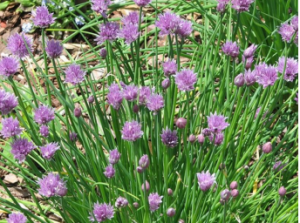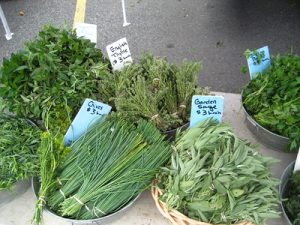Are you a fan of fresh aromatic herbs in your dishes? If so, growing herbs right at home might just become your new favorite hobby.
In this guide, we’ll explore how to grow chives from the comfort of your own home, including some commonly grown varieties that do well in Central Florida. We’ll also highlight specific growing conditions required by chives for optimal growth, pest and disease management, and seasonality.
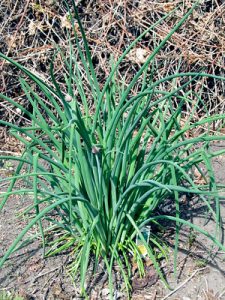
Commonly Grown Varieties
Did you know that chives are part of the onion family? These onion-like plants have slender hollow leaves and grow in clumps. They also make pretty, violet flowers! Not only do chives add a burst of flavor to countless recipes, they’re also relatively easy to cultivate, making them perfect for beginners and seasoned gardeners alike. Chives originated in northern Europe and parts of North America, but with these tips, you’ll be growing chives in your Floridian garden in no time.
The two most common varieties are:
- Common Chives (Allium schoenoprasum):
- Common chives are the most widely used variety, known for their slender green stems and mild onion flavor.
- USDA Hardiness Zone: 3 to 9.
- Growing conditions: Partial shade to full sun with well-draining soil.
- Uses: These chives are perfect for garnishing dishes, adding flavor to salads, soups, and omelets.
- Garlic Chives (Allium tuberosum):
- Garlic chives offer a unique twist with their garlicky flavor and flat, grass-like leaves.
- USDA Hardiness Zone: 3 to 9.
- Growing conditions: Full sun with well-draining soil.
- Uses: Garlic chives are great for stir-fries, dumplings, and as a substitute for garlic in various dishes.

Chives, photo M Fletcher, NC State Extension
Growing Conditions
The best time to plant chives in Florida is August through March. Chives are perennial, which means these plants have a long lifespan that consists of periods of active growth, flowering, and dormancy each year. They will regrow from the same roots year after year.
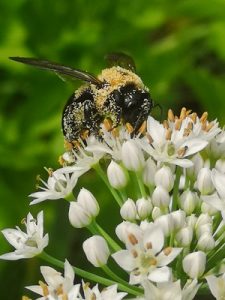
Soil Preparation
Chives prefer moist but well-draining soil. In Florida, it is beneficial to grow chives in raised beds to better control moisture retention and soil texture. Since Florida soil tends to be sandy, so amending your soil with organic matter (like compost) will help your herb thrive. Chives have an optimal pH range of 6.0 to 7.0.
If you don’t already know your soil conditions, a great place to start is with a soil test. UF/IFAS provides Soil Testing Services that are affordable and available to the public. The results will provide valuable information about your soil’s pH, fertility levels, nutrient content, and how to amend your soil to achieve an optimal pH range for the specific plant.
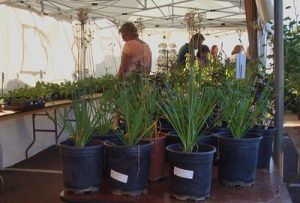
Sunlight
Chives prefer partial shade to full sun. In Florida, providing some shade during the hottest part of the day can prevent the plants from wilting. Chives need at least 4-6 hours of sunlight daily. In winter, protect your plants from frost. You can even grow chives indoors on a sunny windowsill.
To encourage lush growth, harvest chives regularly by snipping the leaves at the base. This promotes new growth and keeps the plants healthy.
Fertilization
Chives thrive in nutrient-rich, well-draining soil, so it is important to fertilize, especially during the growing season. Before planting or transplanting your chives, amend the soil with compost and fertilizer. From there, you can fertilize with a balanced fertilizer according to the label directions. Avoid over-fertilizing, as it can lead to excessive foliage growth with reduced flavor.

Read more about fertilizers in our Fertilizer Fundamentals series:
- Fertilizer Fundamentals: How to Choose the Right One – UF/IFAS Extension Pasco County (ufl.edu)
- Fertilizer Fundamentals: How to Apply Fertilizer – UF/IFAS Extension Pasco County (ufl.edu)
- Fertilizer Fundamentals: The Best Time to Fertilize – UF/IFAS Extension Pasco County (ufl.edu)
Pests and Diseases
While chives are relatively pest-resistant, they can be susceptible to pests like aphids and thrips, as well as diseases like leaf spot and powdery mildew.
Pests
- Aphids: These small, soft-bodied insects can cluster on the undersides of dill leaves, sucking sap and causing damage.
- Treatment: Spray the plant with a strong jet of water to dislodge them or use Neem or insecticidal soap according to label instructions.
- Thrips: Thrips are tiny, slender insects that feed on oregano leaves, causing silvering or bronzing of foliage.
-
- Treatment: Use insecticidal soap or neem oil to control thrips, ensuring thorough coverage of affected plants.
Keep an eye out for any signs such as distorted leaves or webbing on the foliage to prevent an infestation.
Diseases
- Powdery Mildew: Powdery mildew appears as a white, powdery coating on parsley leaves. It can cause leaf distortion and premature leaf drop. It is common in humid in humid conditions, so check your plant for these signs regularly.
- Treatment:
- Ensure proper air circulation around dill plants to reduce humidity levels.
- Apply fungicidal sprays containing sulfur or copper to control powdery mildew.
- Remove and dispose of infected plant parts promptly to prevent further spread.
- Treatment:
To prevent fungal diseases, avoid overhead watering and ensure good air circulation around your plants. If you notice any signs of disease, promptly remove and dispose of the infected leaves to prevent further spread.
Seasonality
Chives are a cool-season herb that thrives in Florida’s fall and spring temperatures. If you want to plant them outdoors, plant them in the fall and harvest them until the weather warms up in late spring.
Alternatively, you can start chive seeds indoors in late summer and transplant them outdoors once the weather cools down.
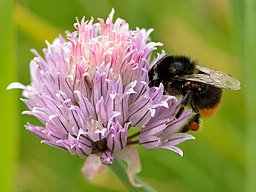
Pruning Chives for Optimal Growth
Regular pruning will promote bushy growth and prevent chives from flowering prematurely. Here’s how to prune chives effectively:
- Where to Prune: When pruning chives, use sharp and clean shears to cut a few inches of the green leaves, or you can cut just above where the stalks emerge from the soil.
- Prune Regularly: Pruning chives should be done regularly throughout the growing season, especially when the plants become overcrowded or start to flower. Aim to prune your chives every 2-3 weeks, removing no more than one-third of the foliage at a time.
- Remove Flower Buds: If your goal is to harvest chive leaves for culinary use, it’s best to pinch off the flower buds as soon as they appear. This will redirect the plant’s energy into producing more foliage, resulting in a longer harvest period.
The flowers will begin to bloom in late May or June, they’re also edible and can be added to salads or flower arrangements. Pollinators love these small purple flower puffs too!
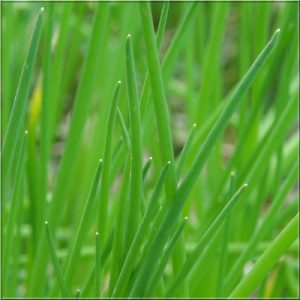
How to Harvest and Store Chives
Harvesting regularly will encourage new growth and keep the plants healthy. For longer storage, you can freeze chives for later use. To freeze chives, chop them into small pieces and store them in an airtight container in the freezer.
To harvest chives, simply snip the leaves at the base of the plant using sharp scissors or shears. The best way to use chives in your dishes is fresh, since they have a delicate onion flavor. Fresh leaves can be used in many dishes like salads, omletes, stews, and soups

Tips for the Floridian Gardener
Florida’s subtropical climate can be both a blessing and a challenge when growing chives. Here are some additional tips to ensure success:
- Choose Heat-Tolerant Varieties: Opt for chive varieties that are well-suited to Florida’s warm temperatures, such as garlic chives or Siberian chives (Allium nutans).
- Provide Afternoon Shade: Protect chive plants from intense afternoon sun by providing them with partial shade during the hottest part of the day.
- Mulch and Water Wisely: Mulching around your chive plants will help conserve moisture in the soil and regulate soil temperature, which is particularly beneficial during Florida’s dry spells and heatwaves.
- Monitor for Pests and Diseases: Keep an eye out for signs of pest infestation or disease and take proactive measures to prevent them from spreading.

“herbs at dupont farmers market” by tvol is licensed under CC BY 2.0. To view a copy of this license, visit https://creativecommons.org/licenses/by/2.0/?ref=openverse.
Conclusion
Growing chives at home is rewarding and provides fresh, flavorful herbs year-round. By following these tips tailored to Florida’s climate, you can enjoy a thriving chive garden in your own backyard. Happy gardening!
Next in the series, we will explore thyme!
Have a question?
If you have any questions about gardening in Central Florida, please contact the UF/IFAS Extension Pasco County at 352-518-0156. For more information on UF/IFAS Extension Pasco County Community Gardens, and how you can join one, visit http://sfyl.ifas.ufl.edu/pasco/.
Follow us!
We have several ways to connect. Visit our Facebook, Instagram, Eventbrite, Blogs, Florida-Friendly Facebook, Website
Supervising agent: Dr. Whitney Elmore
More resources from UF/IFAS Extension Pasco County:
- UF/IFAS Extension Pasco County
- UF/IFAS Extension Pasco County Community Gardens
- Dr. Whitney Elmore’s Podcast: Rooted in Florida
 3
3
